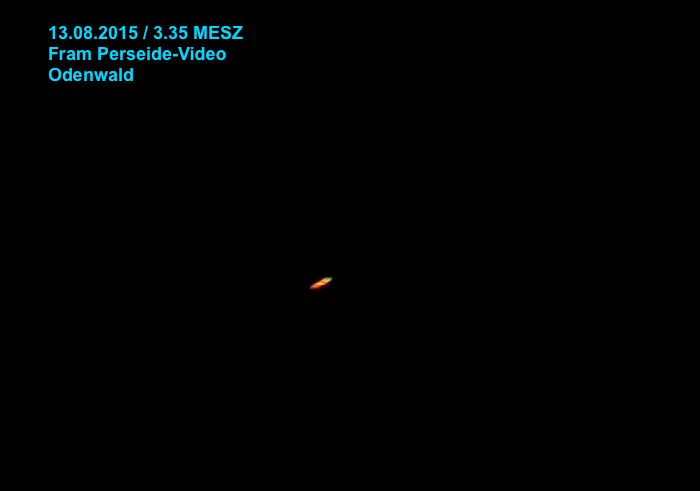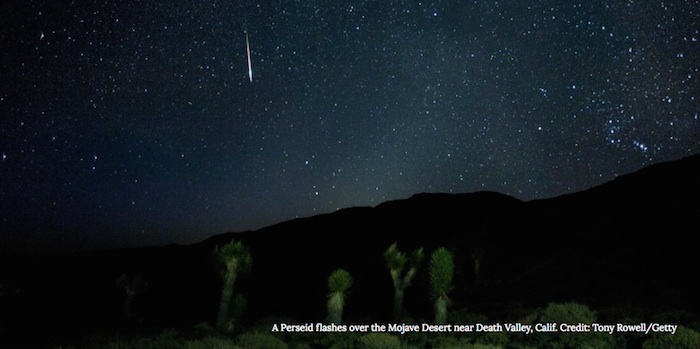.
In den Maximumsnächten können stündlich zwischen 50 und 100 Sternschnuppen über den gesamten Himmel verteilt gesehen werden.
Für 2016 wird auch mit erhöhten Fallraten der Perseiden gerechnet. Vorherberechnungen zeigen für den 12. August um 0:34 Uhr MESZ und insbesondere ab ca. 1:20 Uhr MEZ mögliche höhere Aktivität der Perseiden.
Prognosen sind jedoch oft unsicher.
Der zunehmende Mond (kurz nach dem ersten Viertel) wird so gegen 1 Uhr untergehen. Vorher wird das Mondlicht die Beobachtung etwas beeinträchtigen.
---
Hoffen wir auf klaren Himmel und zahlreiche Sternschnuppen der Perseiden.
-

Quelle: CENAP-Archiv, hjkc

-
Update: 5.08.2016

Update: 8.08.2016.
-
Eyes up for the annual Perseid meteor shower
This year could be an 'outburst' year with twice the number of sightings as usual.

The Perseid meteor shower will peak this week, with the most activity between activity between 11 and 12 August.
The shower, which occurs as Earth passes through the trail left by the Swift-Tuttle comet, is expected to be especially vivid this year. Astronomers say the conditions are right for an “outburst”, with the potential for more than double the usual 80 sightings an hour – at least in the Northern hemisphere.
“Under perfect conditions, rates could soar to 200 meteors per hour,” NASA meteor expert Bill Cooke says.
The meteors light up when specks of material from the comet hit Earth’s atmosphere (or when the Earth’s atmosphere hits it). This shower is called the Perseids because they seem to fly out of the constellation Perseus.
Usually Earth just slides past the edge of the comet’s debris stream but this year, with Jupiter’s gravity pulling the dust closer to us, Earth will pass through the middle of the trail. Astronomers believe this year could be one of those events.
Earth began passing through the cloud of dust on 17 July and will have cleared it by 24 August, but the shower's peak — when Earth passes through the densest, dustiest area — will be between midnight and dawn on the morning of 12 August.
In the Northern Hemisphere, a few Perseids will be visible in the early evening and, while they might not be so plentiful, this is the best time to try to see an “earthgrazer" – a long-lasting meteor travelling horizontally across the sky.
In the Southern Hemisphere, the Preseids are visible from tropical and sub-tropical zones, but not until well after midnight.
Comet Swift-Tuttle is the largest object to regularly swing by Earth, last passing us on its orbit around the sun in 1992. It’s next run will be in 2126.
Quelle: COSMOS
-
Update: 11.08.2016
.
Perseid meteors could see 'surge in activity' on 11 and 12 August
| Last Updated on Wednesday, 10 August 2016 10:29 |
| Published on Tuesday, 09 August 2016 10:08 |
Friday 12 August sees the annual maximum of the Perseid meteor shower. This year, as well as the normal peak on the night of 12/13 August, meteor scientists are predicting additional enhanced activity in the shower the night before, as the Earth passes through a dense clump of cometary debris.
A Perseid shooting star near the Pleiades over Woodingdean, Sussex, on the early morning of the 13th August, 2013. Credit: Darren Baskill.
Meteors (popularly known as 'shooting stars') are the result of small particles, some as small as a grain of sand, entering the Earth's atmosphere at high speed. The parent comet, Swift-Tuttle, which last passed near the Earth in 1992, leaves this debris in the Earth's path. On entering the atmosphere, these particles heat the air around them, causing the characteristic streak of light seen from the ground. The meteors appear to originate from a single point, called a 'radiant', in the constellation of Perseus, hence the name of the shower.
Russian astronomer Mikhail Maslov and Finnish astronomer Esko Lyytinen predict that this year the Earth will pass through a stream of cometary material shifted towards us by Jupiter's gravitational field. According to their model, and work by French scientist Jeremie Vaubaillon, we could see a steep rise in activity from late evening on 11 August to 0500 BST on 12 August.
The Perseids are typically active from around 17 July to 24 August, although for most of that period only a few meteors an hour will be visible. During the peak, and if the predictions by Maslov, Lyytinen and Vaubaillon are right, as many as 100 meteors or more may be seen each hour. This year, the light from the waxing gibbous Moon will interfere to some extent for the first part of the night, so observers are advised to look out in the early morning hours after midnight when the Moon is very low in the sky or has set.
A late-evening meteor above Leith Hill, Surrey, during the Perseid shower of August 2014. Credit: Sam Lindsay (RAS).
Professor Mark Bailey, Director Emeritus of Armagh Observatory, said "The Perseid meteor shower is one of the best and most reliable meteor showers of the year, and the predictions of a surge in activity this year make it particularly exciting this time. If you're lucky enough to have a clear sky early in the morning on 12 August, I'd definitely get up to take a look."
Dr David Asher, also at Armagh Observatory, continued, "If you're clouded out on the morning of the 12 August, you still have a chance to see the normal maximum the next night."
Unlike many celestial events, meteor showers are straightforward to watch, and for most people the best equipment to use is simply the naked eye. Advice from experienced meteor observers is to wrap up well and set up a reclining chair to allow you to look up at the sky in comfort. If possible it also helps to be in a dark place away from artificial light, and to have an unobstructed view of the sky.
Although the number of visible meteors is hard to predict accurately, you can expect to see at least one every few minutes. They mostly appear as fleeting streaks of light lasting less than a second, but the brightest ones leave behind trails of vaporised gases and glowing air molecules that may take a few seconds to fade.
Quelle: Royal Astronomical Society


